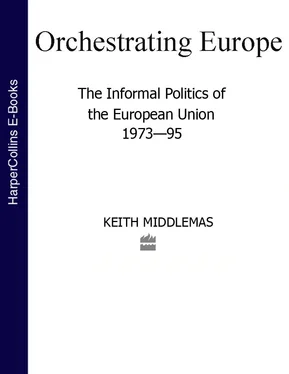After some struggles with the Council, which initially refused to give the Commission regulating powers, a policy emerged via a combination of exemptions, rulings of the EJC and Decisions by the Commission; which tried to ban price fixing, market sharing, production quotas, vertical distribution agreements, certain aspects of the exploitation of commercial property rights, and collective exclusive dealing. Implementation of this policy, however, remained fraught with difficulties. Obviously, restrictive agreements which the participants felt unlikely to be accepted were rarely notified. The villains of the piece were secret, large, international, horizontal producer agreements where the Commission had problems in securing evidence and prosecuting cases. Progress on this front was halting and sporadic but, since there is still no assessment of the prevalence of cartels in the 1960s, it is difficult to assert the effectiveness of the Community’s efforts. The contemporary merger boom and the spread of multinationals in these same years complicated matters; and to some extent these new commercial arrangements built on tacit measures of cooperation existing earlier.
The Spaak Report (1956) had argued that the advantage of a Common Market ‘lies in the fact that it reconciles mass production with the absence of monopoly’. It was assumed – and hoped – that European enterprises would adapt to the new situation by becoming bigger entities, enjoying economies of scale and enhanced productivity. Herein lay the route to improved competitiveness, above all, through the example of US firms. Throughout the discussion on the ‘technological gap’ and the ‘American challenge’, the size of US enterprises was seen as the main reason for their superiority over their European counterparts. On the other hand, the Treaty of Rome hoped to avoid dominant positions – or at least their abuse (cf. art. 86) – and to ensure competition. The European Communities had to find some way through this dilemma to define their policy.
The Commission initially adopted a largely passive stance: in 1963, the question of ‘concentration’ was handed to a group of experts who produced a first memorandum in 1966. Although this reiterated the need to preserve competition, it laid more stress on the positive aspects of concentration. The Commission’s first aim was to reduce impediments to certain forms of merger. The reason may have been the poor results of cross-frontier mergers within the EEC (only 257 in the period 1961–9) compared with domestic mergers (1861) and those involving third countries (1035). At the same time, the Commission demanded powers to control mergers that threatened to acquire a dominant market position. It did not acquire these powers then, and when it did, in 1973, it was only in the form of rights to prior notification. The intervening years had been marked by complex legal arguments on the way in which the relevant articles were to be applied, arguments that could have been avoided, ‘if there had been any real political will amongst the member states for a merger policy’.
It was obvious that the dismantling of tariffs by both the EEC and EFTA, as well as the EEC’s introduction of a CET, was going to have some impact on the international pattern of trade. Modern customs union theory predicted two effects from the dismantling of tariffs and the introduction of a CET: trade creation, that is a shift from higher-cost producers to other EEC sources whose goods had become cheaper with the dismantling of tariffs; and secondly, trade diversion, that is a shift from lower-cost foreign sources to higher-cost EEC sources that benefited from tariff preferences whilst the external tariff was maintained. Intra-area trade would expand; in the first case because of a more optimal use of resources and in the second at the cost of less optimal sources. Much empirical research has been done to determine the balance of advantage. 22
Trade within the blocs rose considerably. That of the EEC increased from $7530m to $49,830m between 1958 and 1971 and within EFTA in the same period from $28oom to $ 11,190m. In both cases, trade between bloc members grew faster than their trade with the rest of the world. EEC exports to EEC countries rose from 32.1% to 49.4% in these years while the percentage share for EFTA exports to EFTA countries rose less dramatically from 17.5% to 24.3%. Before trying to apportion the balance of advantage, one has to consider that increased intra-bloc dependence is not exclusively a function of the manipulation of commercial conditions. In a period when the growth centre of world trade lay in the exchange of increasingly sophisticated manufactured goods, it would not be surprising to see developed economies in close geographical proximity doing particularly well. Equally, performance within groups may be determined by differential growth rates. EFTA, which included the relatively sluggish UK economy, may appear less ‘successful’ than the EEC, with the rapidly-expanding German economy at its core. For example, EC exports to EFTA fell from 21.1% to 16.6% whilst the share of EFTA exports to EEC countries rose from 22.8% to 25.4%, despite the maintainance of tariffs or the deflection of agricultural trade.
Singling out an EEC-effect is not easy and the various attempts that have been made to do so have been much discussed. The so-called ex-post models cover a period when the EEC was in operation, and try to find out what the world would have been like if the EEC had not existed. To estimate trade in such cases, one has to rely on some ceteribus-paribus assumptions, so that the findings are always problematic. Hence Sellekaerts’s warning ‘that all estimates of trade creation and trade diversion by the EEC are so much affected by ceteribus-paribus assumptions, by the choice of benchmark year (or years), by the method to compute income elasticities, by changes in relative shares and by structural changes not attributable to the EEC but which occurred during the pre- and post-integration periods (such as the trade liberalization among industrial countries and autonomous changes in relative prices), that the magnitude of no single estimate should be taken too seriously’. Notwithstanding this destructive comment, it has to be admitted at, despite the different methodologies employed, most studies suggest that trade creation outweighed trade diversion, so that a net gain was achieved. Furthermore, Davenport has stressed the fact that ‘the divergence in estimates is relatively limited, with the majority clustered in a range going from $7.5bn to $11.5bn for trade creation and from $0.5bn to $1bn for trade diversion.’
Very few estimates break this ‘gain’ down into individual national components. Two studies that do this come to broadly similar conclusions. The Benelux countries benefited least, since they already had the lowest tariffs and because the mutual Benelux preferences had to be diluted in the common market (a case of trade erosion). There is a noticeable gap between these countries and the other three. Despite having the next lowest tariffs, Germany benefited the most, reflecting both its export structure and its ability to make inroads into the markets of partner states. France and Italy followed close behind. 23
Some authors contend that these calculations underestimate the impact of trading blocs. They stress that increases in market size and the impact of certainties in irreversibly reduced frontier barriers to trade induced a favourable investment climate and economies of scale, at least in sectors engaged in trade. Indeed, in the Italian case, the difference between a hyper-efficient export sector and a more backward domestic sector had led to the economy being analysed in terms of ‘economic dualism’, even before the full impact of the EEC was felt.
Growing commercial interdependence especially among the EEC states prompted concern among their governments over whether or not to tie their currencies closer together. The implications of moving to convertibility in 1958 quickly became apparent because the US balance of payments deficit remained acute. In the 1950s, this had been the main source for replenishing reserves. By the early 1960s, however, central banks in the EEC member states held about all the dollars they wanted. Yet the inflow of dollars continued unabated, attracted by the investment opportunities offered by the rapidly expanding EEC economies, or seeking a quick return by exploiting the relatively high interest rates on offer in Europe. Some of these funds were exchanged for US gold, some remained in the vaults of European central banks, and some were held by the private banking system. The latter formed the basis for the so-called Eurodollar market and provided a growing wash of international liquidity highly responsive to changes in, or rumours of changes in, market conditions. International speculation in foreign currencies became a daily fact of life. In such circumstances the desire for some preemptive, collective defence mechanism assumed a higher place in the aspirations of the Six. 24
Читать дальше









![Brian Thompson - A Monkey Among Crocodiles - The Life, Loves and Lawsuits of Mrs Georgina Weldon – a disastrous Victorian [Text only]](/books/704922/brian-thompson-a-monkey-among-crocodiles-the-life-thumb.webp)


